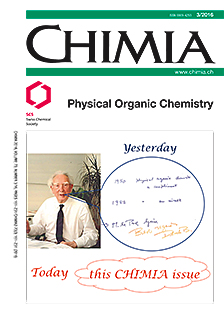Effect of the C(3)-Substituent in Verdazyl Radicals on their Profluorescent Behavior
DOI:
https://doi.org/10.2533/chimia.2016.172Keywords:
Epr, Profluorescence, Spin traps, Tddft, Verdazyl radicalsAbstract
Methods for the detection of reactive intermediates such as transient radicals are important in organic chemistry, polymer chemistry, biology or medicine. Along these lines we recently reported that 1,5-diphenyl-6-oxo verdazyl radicals can be used as fluorescent spin sensors. In situ generated C-centered radicals are efficiently trapped by the verdazyls, which in turn undergo transformation from a paramagnetic non-fluorescent state to a diamagnetic fluorescent state. Whereas the N-phenyl substituent in the spin probes is of high importance for obtaining profluorescent behavior, the effect of the C(3)-substituent has not been investigated to date. We herein present the synthesis and characterization of various 1,5-diphenyl-6-oxo-verdazyl radicals bearing differently hybridized C-substituents at the C(3) position. Steady-state and time-resolved fluorescence spectroscopy in solution and in the solid state along with time-dependent density functional theory (TDDFT) calculations reveal that a C(3)-aryl substituent is crucial for obtaining fluorescence after spin trapping. In addition, it is shown that the emission wavelength of the C(3)-aryl substituted verdazyl derivatives can be tuned by selective destabilization of the HOMO and the LUMO.Downloads
Published
2016-03-30
Issue
Section
Scientific Articles
License
Copyright (c) 2016 Swiss Chemical Society

This work is licensed under a Creative Commons Attribution-NonCommercial 4.0 International License.
How to Cite
[1]
Chimia 2016, 70, 172, DOI: 10.2533/chimia.2016.172.







